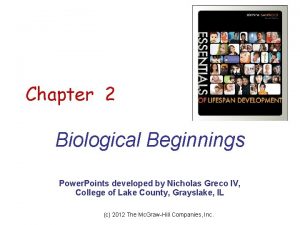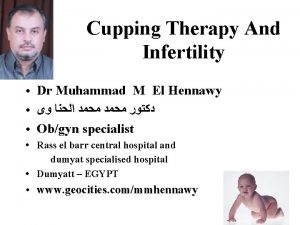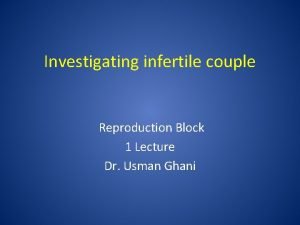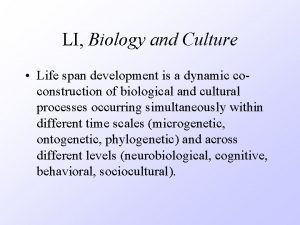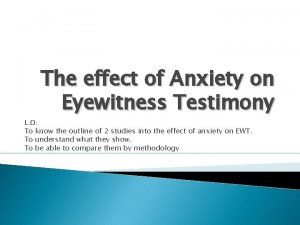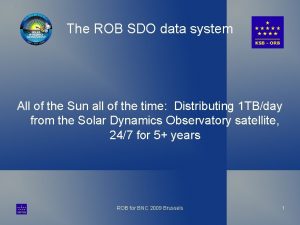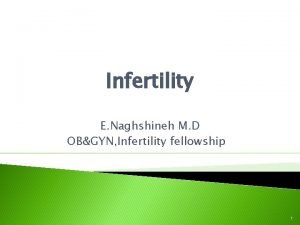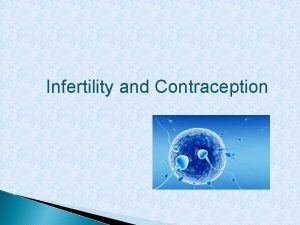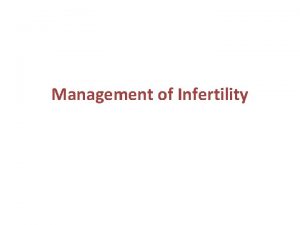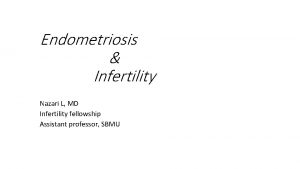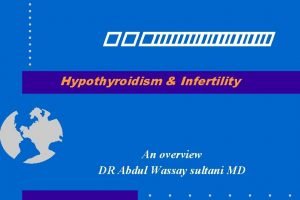INFERTILITY AN OVERVIEW n Infertility affects 15 of


























- Slides: 26


INFERTILITY – AN OVERVIEW n Infertility affects 15% of all couples trying to conceive (1 in every 6) n Male factor held responsible in roughly half of all cases of infertility

INTRODUCTION § Spermatogenesis : Complex, diverse, 74 days § Sperms prone for disruption by potential targets § Most significant - free radicals § Species with unpaired electrons, highly reactive

OXIDATIVE STRESS ? § Overproduction of free radicals (ROS) § Decreased clearance of ROS by scavenging mechanisms § Imbalance – results in oxidative stress § Oxidative stress – disruption of functional competence of human spermatozoa


HYDROGEN PEROXIDE § Sperm plasma membrane § Loss of membrane fluidity and integrity § Sperm DNA § Strand breaks & oxidative base damage § Loss of competence to participate in membrane fusion events - fertilization

ASSESSMENT OF DNA INTEGRITY ü High levels of DNA fragmentation, decline in spermoocyte fusion rates and motility - exposure to H 2 O 2 (Aitken et al. , 1998) ü Level of DSB’s high in infertile patients with abnormal semen parameters (Agarwal et al. , 2004) ü High proportion of sperm with DNA damage - may be a cause of infertility (Singh et al. , 2003) ü Studies - DNA fragmentation - sperms used for ART. Evidence is accumulating on the importance of sperm DNA integrity during both fertilization and embryogenesis (Miller et al. , 2002)

COMET ASSAY § Routine examination of sperm & need for novel techniques § Advantages § Simple, non invasive § Fast, relatively inexpensive, highly sensitive § Applied to any eukaryotic cell § Less amount of sample required § Software facilitated analysis

OBJECTIVE n To standardize a protocol for the evaluation of genomic integrity of the human spermatozoa exposed to hydrogen peroxide treatment using comet assay

TECHNIQUE § MICROGEL PREPARATION § SAMPLE PREPARATION - SWIM UP METHOD § EMBEDDING OF CELLS IN MICROGELS § LYSIS - USING HIGH SALT & DETERGENTS § EXPOSURE TO HYDROGEN PEROXIDE § ALKALINE ELECTROPHORESIS § NEUTRALISATION AND STAINING § IMAGE ANALYSIS & AND INTERPRETATION





RESULTS § 4 different protocols followed which differed in § § Composition of buffers Duration and temperature of lysis Level of genotoxic insult Electrophoretic conditions § Each of the experiment done for at least 3 times and Protocol 2 – best results § ? Due to longer duration of lysis and high levels of ROS induction

DIFFERENCE IN THE METHODOLOGIES ADOPTED FOR COMET ASSAY Protocol Lysis Electrophoresis Neutralisation 1 Lysis with proteinase K solution at 37 °C for 2 hours 12 V at 250 m. A for 20 minutes at room temperature 30 minutes at 4 °C 2 Lysis for 1 hour at 4 °C 25 V at 300 m. A for 5 followed by overnight minutes at room incubation with temperature Proteinase K solution at 37 °C 3 4 Lysis at 4 °C for 1 hour followed by incubation with dithiothreitol solution for 30 minutes at 4 °C Lysis for 1 hour at 4 °C 30 minutes at 4 °C 25 V at 300 m. A for 10 minutes at room temperature 30 minutes at 4 °C 20 V at 300 m. A for 20 minutes at room temperature 30 minutes at 4 °C





DISCUSSION n n Reproducible and Reliable results • Strict quality control • All steps equally important No single correct method -critical steps Slide preparation Goal - uniform gels with stability & easy visualization Important parameters Concentration of cells in agarose & agarose concentration itself

DISCUSSION… n 5 ml of 1% agarose at 70 -80°C for 2 hrs –best results n Single layer procedure suited the study n Cell density n Optimal number of cells n Not > few per visual field n Higher cell densities n Overlapping comets at higher levels of DNA migration

DISCUSSION… n Lysis - parameters - highly variable n Detergent & Reagent requirements n Duration and temperature of lysis n Minimal time required n Incubation of slides in a solution of Proteinase K at 37°C for 8 hours n Genotoxic agent n Nature, concentration, sequence of steps in the assay

DISCUSSION… n Electrophoresis Length of time for unwinding and expression n Electrophoretic conditions n Ideal - 25 V, 300 m. A for 5 minutes at room temperature n n Neutralization Optimal time - 30 minutes at 4°C n Use of chemical Spermine - enhanced the clarity n

CONCLUSION n An in vitro assay with human spermatozoa - valuable sensitive system - assess potential genetic effects - various factors in human reproduction n Need for assessment further intensified - genetic disorders transmitted through ART’s n The comet assay - promising tool - evaluation - genetic aspects of male infertility

CONCLUSION…. n ? of the different protocols would be the most useful for description of clinically relevant sperm DNA damage is yet to be determined n The comet assay - yet to undergo - appropriate multilaboratory, international validation studies demonstrate - interlab and intralab reproducibility, reliability and adequacy of it’s performance against the currently adopted methods
 Thinking affects our language which then affects our
Thinking affects our language which then affects our Cystic fibrosis male infertility
Cystic fibrosis male infertility Hijama points for female infertility
Hijama points for female infertility Female infertility
Female infertility Hijama before ivf
Hijama before ivf Sherman j. silber
Sherman j. silber Hormonal surge meaning
Hormonal surge meaning How perception affects communication
How perception affects communication How eating healthy affects your body
How eating healthy affects your body Perception checking process
Perception checking process Pcm companding
Pcm companding Give at least 4 modifiers of the human acts
Give at least 4 modifiers of the human acts How culture affects decision making
How culture affects decision making This affects us
This affects us Culture is affects biology
Culture is affects biology A teacher affects eternity meaning
A teacher affects eternity meaning Igor areh
Igor areh What affects rate of weathering
What affects rate of weathering How sports affect mental health
How sports affect mental health A bacterial std that usually affects mucous membranes
A bacterial std that usually affects mucous membranes Passengers can help a driver better manage emotions by
Passengers can help a driver better manage emotions by Chromatic aberration affects reflector telescopes.
Chromatic aberration affects reflector telescopes. Glencoe health chapter 1 understanding health and wellness
Glencoe health chapter 1 understanding health and wellness How derivatives affect the shape of a graph
How derivatives affect the shape of a graph What affects rate of weathering
What affects rate of weathering What is catalyst and how it affects reaction rate
What is catalyst and how it affects reaction rate This affects us
This affects us

